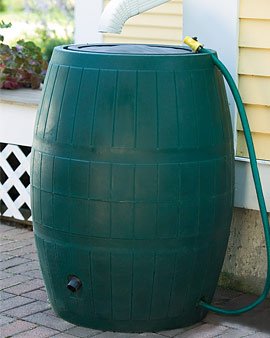
FREE Garden Journal!!
Join "Garden Notes" and plan for Harvest Success as you track and record your gardening progress. Your Free Personal Garden Journal has pages for jotting down notes on the seeds you start, your new plantings, when you fertilized, and even a graph to plot a new garden.
How To's | Technique | Practical Advice | Children | Internet Gardening | Vermicomposting | Pest Management


Rain Barrel Facts
Stormwater Facts
Your rain barrel will help slow runoff and encourage infiltration.
View Precipitation Flat
- Rooftops are impervious surfaces, along with roads, parking lots, driveways and even compacted soils.
- In a pristine area, even an additional 10% of impervious area alters the natural rainfall runoff cycle and has the potential to damage sensitive ecosystems.
- Infiltration, allowing the water to soak into nearby soils, will recharge groundwater supplies and return the water cycle to a more natural path.

Water Conservation Facts
Your rain barrel will help conserve water.
- Water usage increases in the summer by 30% due to the increase in outdoor water use such as lawn watering, flower and vegetable watering, car washing, and pavement cleaning.
- Your water supply is unique to your location.
Q. How much rainfall is needed to fill a typical 55-gallon rain barrel?
A. The typical home has a roof area of 1,200 sq. ft. and four downspouts,
each collecting from an area of 300 sq. ft. A rainfall of only 0.3 inches
will fill the rain barrel.
Q. If I place a 55-gallon rain barrel at the bottom of each of 4 downspouts
of my 1200 sq. ft. roof, how many times will they fill up?
A. From May 1 to September 30 each barrel will fill up about 15 times.
IMPORTANT: Do not use rain barrels for drinking, cooking or bathing. If moss killer has been used on the roof, let a few rain events bypass the barrel before collecting water.
Managing Your Rain Barrel
During the Growing Season and Winter

Waterwise gardening with the rain barrel: Rain patterns occur so that more rainfall events occur during April, May and June, just when you are establishing your vegetable garden and working in perennial beds. A waterwise approach could be to water annuals and perennials with rain barrel water and mulch heavily to retain moisture during the dryer months of July and August. However, don't despair, rain showers can occur in July and August to refill the barrels.
Increase your capacity of rainwater storage: Connect more than one barrel together at each downspout. Remember to raise your barrels off the ground by placing them on cement or wooden blocks to ease access to the faucet.
Manage heavy rains: It is essential to consider impact of heavy winter rains on your drainage system. An overfull rain barrel has the potential to erode your home's foundation. In all cases your rain barrel should have an overflow spigot near the top on the side. Management ideas include:
- Connect a hose to the overflow spigot and direct this away from your foundation, a minimum of 2 feet for a crawlspace, and 6 feet for basements.
- Disconnect the rain barrel from the downspout and return the system to its original configuration.
- Leave the outlet faucet open and set a splash block under it. Now the rain barrel is an extension of the downspout drainage system. Remember to close the faucet when you desire to fill the rain barrel.
- Whatever you solution, design the overflow system to encourage infiltration of the water into the ground.
Please Protect Water Quality
Do not send overflow across parking areas, driveways septic drainfields,
bare soil, or storage areas for pesticides or heavy equipment
Keep Pollutants out of our streams


